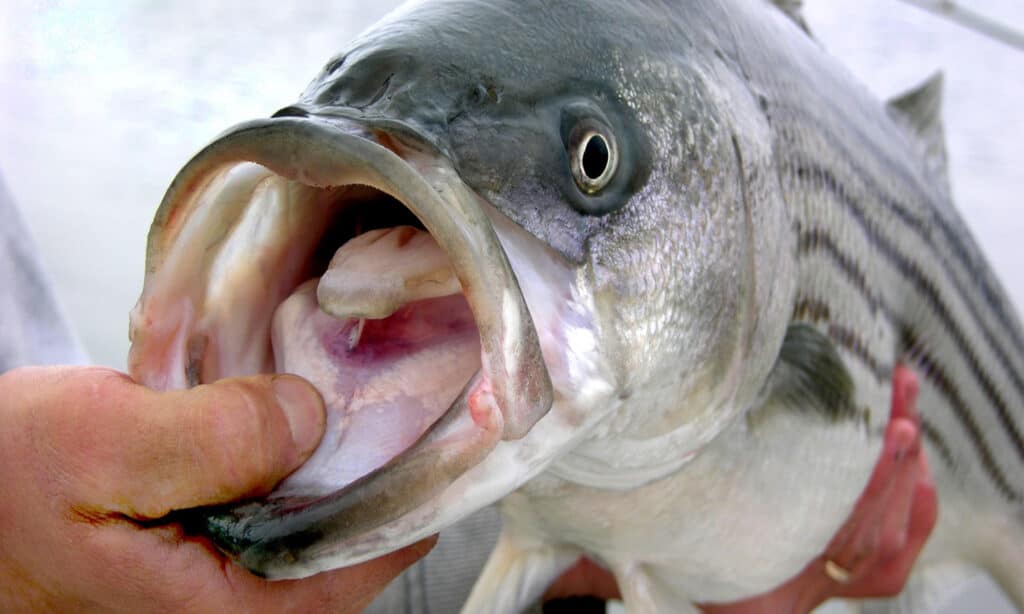Florida is a fisherman’s paradise. Full of lowlands, backwaters, lakes, streams, and coastline, it’s almost hard to drop a line somewhere in the state and NOT catch anything. As a result, Florida has become one of the best places in the United States to go fishing for freshwater and saltwater catches. Today, we will be looking at one of the best game fish in the state: the striped bass. Let’s discover the largest striped bass ever caught in Florida!
The Largest Striped Bass Ever Caught in Florida

The largest striped bass ever caught in Florida was a 42.25 lb fish caught in December of 1993 by fisherman Alphonso Barnes.
©Steve Brigman/Shutterstock.com
There is a lot of game fish in Florida, but striped bass is and will always be a favorite. Since these fish can get relatively large, they are a favorite for anglers all over the United States. These fish are what’s known as “anadromous,” meaning they can live in fresh or salt water, although they usually reach their maximum size while in saltwater. Still, they do come inland to spawn and breed, giving anglers all over the state a chance to catch them.
The largest striped bass ever caught in Florida was a 42.25 lb fish caught in December of 1993 by fisherman Alphonso Barnes. The fish was caught in the Apalachicola River in Gadsden, Florida.
The Florida record is recorded on Big Catch Florida, although larger striped bass has likely been caught, just not documented. The record in Florida was caught on the Apalachicola River, a river located in the panhandle. It originates in the Appalachian Mountains of Georgia and flows southward through Alabama and into the Florida panhandle, where it empties into Apalachicola Bay, an inlet of the Gulf of Mexico. Striped bass swim into the river to spawn, which is likely how the record was tracked inland and not on the coast.
The Types of Bass in Florida
Bass can be found in almost every body of water in Florida, including the storm drains along most major roads. Here are some of the most common bass, plus a short description of what they look like (aside from striped bass):
- Largemouth bass (Micropterus salmoides)
- Smallmouth bass (Micropterus dolomieu)
- Suwannee bass (Micropterus notius)
- Spotted bass (Micropterus punctulatus)
Largemouth bass (Micropterus salmoides) are Florida’s most widely distributed and sought-after gamefish. They are known for their large, olive-colored bodies and distinctive black lateral stripe. They can grow up to 30 inches in length and weigh up to 22 pounds.
Smallmouth bass (Micropterus dolomieu) are smaller than largemouth bass, typically reaching a maximum size of about 20 inches and 5 pounds. They have a more streamlined body shape and a brown or bronze coloration with dark blotches on the sides.
Suwannee bass (Micropterus notius) are a rare and endangered species that are found only in the Suwannee River system in Florida and Georgia. They have a light-colored body with dark vertical bars and a short, broad head. They can grow up to about 15 inches in length.
Spotted bass (Micropterus punctulatus) are similar in appearance to largemouth bass, but have a more slender body and a smaller mouth. They are generally olive-colored with dark spots on their sides and can grow up to about 18 inches in length.
Where to Catch Striped Bass in Florida

Striped bass are less common in Florida compared to other parts of their range.
©Carolyn Davidson Hicks/Shutterstock.com
Striped bass, also known as stripers, can be found in a few select rivers and waterways in Florida. These include the Apalachicola River, the St. Johns River, and their tributaries, as well as Lake Talquin and the Ochlockonee, Blackwater, Nassau, and St. Marys rivers.
Striped bass requires flowing water to reproduce and are sensitive to high water temperatures, so they are less common in Florida compared to other parts of their range (specifically to the north). In order to maintain striped bass populations in Florida, the state relies on stocking programs from hatcheries. There aren’t striped bass everywhere in the state, but if you know where to look, you can catch them!
Striped Bass, a Quick Overview:
Distribution and Habitat
Striped bass have a wide distribution, ranging from the St. Lawrence River in Canada to the Gulf of Mexico in the United States. In terms of habitat, striped bass can be found in both marine and freshwater environments, with adults typically returning to their native streams to spawn. The ability to tolerate both freshwater and saltwater is labeled “anadromous.
Diet
In terms of diet, striped bass feed on a variety of prey, including other fish, squid, and crustaceans. They are known to be opportunistic feeders and will eat whatever is available in their environment. Anglers have caught striped bass with hot dogs and squid, as well as other traditional kits.
Predators
Striped bass have a few natural predators, including larger fish, birds, and marine mammals.
Uses
In terms of human uses, striped bass are valued for their meat and are a popular gamefish for recreational anglers. They are also farmed for commercial purposes and can be found in markets and restaurants.
Up Next:
- What Do Striped Bass Eat?
- Sea Monsters! The 10 Biggest Trophy Fish Ever Caught in North Carolina
- 3 Florida Lakes with Alligator Attacks in 2022
The photo featured at the top of this post is © Tfreeman_Films/Shutterstock.com
Thank you for reading! Have some feedback for us? Contact the AZ Animals editorial team.






